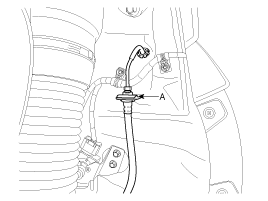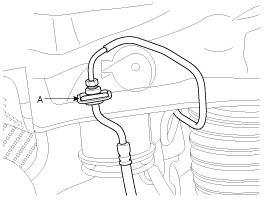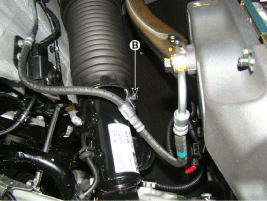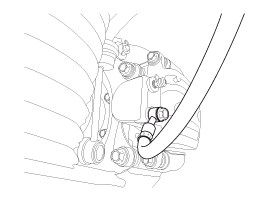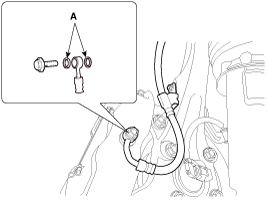 Hyundai Equus: Brake Line Repair procedures
Second generation VI (2009–2024) / Hyundai Equus VI 2009-2024 Service Manual / Brake System / Brake System / Brake Line Repair procedures
Hyundai Equus: Brake Line Repair procedures
Second generation VI (2009–2024) / Hyundai Equus VI 2009-2024 Service Manual / Brake System / Brake System / Brake Line Repair procedures
Second generation VI (2009–2024) / Hyundai Equus VI 2009-2024 Service Manual / Brake System / Brake System / Brake Line Repair procedures
| Removal |
| 1. |
Remove the wheel & tire. |
| 2. |
Remove the brake hose clip (A).
Front
Rear
|
| 3. |
Disconnect the brake tube by loosening the tube flare nut.
|
| 4. |
Disconnect the brake hose from the brake caliper by loosening
the bolt. And loosen the braket bolt for disconnect the brake line.
Front
Rear
|
| Inspection |
| 1. |
Check the brake tubes for cracks, crimps and corrosion. |
| 2. |
Check the brake hoses for cracks, damage and fluid leakage. |
| 3. |
Check the brake tube flare nuts for damage and fluid leakage. |
| 4. |
Check the brake hose mounting bracket for crack or deformation. |
| Installation |
| 1. |
Installation is the reverse of removal.
|
| 2. |
After installation, bleed the brake system.
(Refer to Brake System - "Brake System Bleeding") |
| 3. |
Check the spilled brake oil. |
 Brake Line Components and Components Location
Brake Line Components and Components Location
Components
...
 Brake Pedal Components and Components Location
Brake Pedal Components and Components Location
Components
1. Brake pedal member assembly2. Stop lamp switch3. Clevis pin 4. Snap pin5. Brake pedal 6. Return spring7. Bolt
...
See also:
Canister Close Valve (CCV) Repair procedures
Inspection
1.
Turn the ignition switch OFF.
2.
Disconnect the CCV connector.
3.
Measure resistance between the CCV terminal 1 and 2.
4.
Check that the resistance is within the specific ...
Trunk Lid Trim Components and Components Location
Component Location
1. Trunk lid trim
...
27 Brake Control Solenoid Valve Specifications
Specifications
Direct control VFS[27/B]
x Control type : Normal low type
Control Pressure kpa (kgf/cmx, psi)0~1569.06 (0~16,0~227.57)Current value(mA)0~1100 Internal resistance ...
Categories
Hyundai Equus Manuals
© 2011-2024 Copyright www.heqmanual.com

